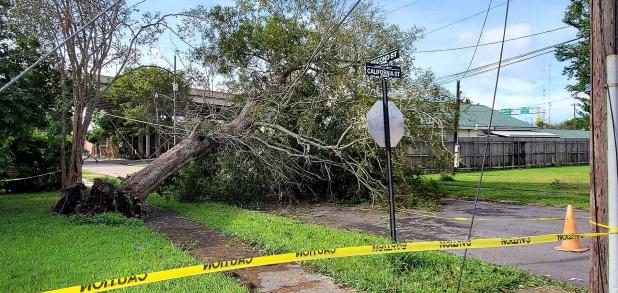
Hurricane Ida devastated portions of south Louisiana after shifting east from its expected landfall near St. Mary.

Vermon Norwood prepares for the Tokyo Olymics.
The Review/Geoff Stoure

Although Hurricane Ida made landfall east of St. Mary, the storm felled utility poles and trees in east St. Mary, including this tree in Berwick.
The Daily Review/Diane Miller Fears

The Berwick 10U softball team won state and regional titles to qualify for the Babe Ruth World Series in Jensen Beach, Florida.
The storm that missed, the virus that hit: Ida, COVID made news in Tri-City area
We feared a direct hit from one of the most dangerous hurricanes to strike Louisiana. It missed us, mostly.
We weren’t expecting a new variety of COVID-19 to take us back to the days of masks, jammed hospitals and limits on occupancy in public places. But the virus hit us.
We applauded the accomplishments of an adopted St. Mary resident at the very highest levels of track and field, and a team of preteen girls from Berwick who didn’t know how to give up.
St. Mary Parish residents learned that there aren’t as many of us at the end of the decade as there were at the start.
We waited to cross to bridges. A lot.
Those were among the biggest stories in the Tri-City area in 2021. Most of us won’t miss the trepidation and irritation that another year of pandemic brought us. But 2021 had its shining moments, too.
Ida: The
'whew' factor
Ida caused death and destruction from Venezuela to New York, killing at least 95 people from late August into early September.
But for St. Mary residents, the scariest days were from about Aug. 26 until landfall Aug. 29. That’s when the forecast track left open the possibility that Ida would come ashore somewhere near Morgan City — in the worst case, just to the west — with winds of at least 110 mph.
The new forecast cone issued by the National Hurricane Center every three hours continued to show something like a direct hit until only about 20 hours before landfall. Then, about 4 p.m. Aug. 28, the forecast began to show an easterly movement in the storm’s path.
That move continued until Ida’s center hit Port Fourchon Sunday, Aug. 29, 16 years to the day from when Katrina devastated New Orleans.
The storm hit with sustained winds of 150 mph, Category 4 strength, with reports of gusts of up 172 mph. Ida tied 2020’s Hurricane Laura as the strongest storm to hit Louisiana in at least 150 years.
At least 33 Louisiana people died in the storm or its aftermath. Virtually all of Terre-bonne and Lafourche was without electricity immediately after the storm, and many residents of those parishes waited for weeks to have power again.
Buildings in the strike zone were devastated. Ports, schools, businesses and government offices were shut down, some for weeks.
Every building in Grand Isle sustained some damage. Nearly half were destroyed.
St. Mary didn’t escape entirely unscathed. Trees and utility poles were knocked down here and there in the eastern part of the parish. Power was out over large stretches of the area until at least Aug. 30. And we learned how vulnerable cellphones can be to bad weather when service was interrupted on some carriers for several days.
When the lights came back on, we learned that we don’t have to take a direct hit to feel a storm’s effects.
Suddenly, eastern St. Mary was on the boundary between parishes to the east, where people couldn’t get gas or groceries, and evacuees returning from the west. The roads were crowded. So were grocery stores, where employees hustled to keep high-demand items in stock. Gas stations experienced long lines and frequent shortages of fuel.
Traffic control and the need to keep order at gas stations added to the burden on first responders, many of whom had been working extra hours even before the storm hit.
To make matters worse, the interruption in data service affected the modern communications systems used by police.
Ida left Louisiana to spawn tornadoes in the eastern United States and flash flooding in New York City. Esti-mates of the damage inflicted by Ida range upward from $65 billion.
The delta variant
Not even 16 months of life and death with COVID-19 could prepare us for the speed and power with which the new delta variant hit St. Mary.
By mid-summer, new cases of COVID-19, along with COVID deaths and hospitalizations, had been on the wane since the peak of the third wave of infections over the winter. Most mask mandates and public occupancy restrictions were gone.
Best of all, three COVID vaccines — the two-shot Moderna and Pfizer formulations, and the one-shot Johnson & Johnson vaccine — had been widely available since the spring. Public health officials said the vaccines, limited to adults at first and eventually offered to children as young as 5, are 90% effective.
St. Mary people were slow to embrace vaccinations. By July, less than 30% of the parish’s population had been vaccinated, trailing the state and the nation.
The first confirmed Louisiana case of infection with the delta variant came around the first of July. By the middle of the month, St. Mary was one of two parishes characterized by the state Health Department as being at “highest risk” for COVID, based on the positivity rate of COVID tests and the average number of new cases each day over the course of two weeks.
At the first of August, the number of deaths began to rise. Through August and much of September, St. Mary averaged more than one COVID death per day.
Between Aug. 1 and the end of October, when newly imposed restrictions were lifted again, 74 St. Mary people died of COVID-related causes. More than 2,600 St. Mary people tested positive for COVID over that time.
The new surge in COVID cases led to the cancellation of the Louisiana Shrimp and Petroleum Festival for the second straight year.
Statewide, the delta-fueled fourth surge in COVID cases pushed the number of hospitalized people to a peak above 3,000.
As the year ends, public officials are monitoring the threat from another variant, this one called Omicron. This variant, already the dominant form of COVID in the United States, is said to be more easily spread but less severe than delta based on the early data.
But statewide hospitalizations had risen from 207 to 514 Dec. 17-28. More than 200 new COVID cases have been reported in that time in St. Mary, where the vaccination rate is now just over 42%.
Tootie
Vernon “Tootie” Norwood came to Morgan City with his family from New Orleans in 2005 to escape the damage inflicted by Hurricane Katrina. Coaches in the public schools here persuaded him to come out for track.
They knew talent when they saw it.
LSU’s website calls Norwood “one of the greatest 400-meter runners ever to wear an LSU uniform.” He was a four-time NCAA champion, an eight-time All-American and a nine-time All-SEC performer. In 2015, he won both the NCAA indoor and outdoor championships in the 400 meters.
An injury kept him out of the 2016 Olympics, and the Tokyo games were postponed because of COVID in 2020.
But the Olympics got the green light in 2021, and Norwood was ready for Tokyo.
He was part of two U.S. relay teams that won medals — the 4x400 mixed relay, which won the bronze, and the men’s 4x400 relay, for which he ran in a qualifying heat. The men’s team went on to capture the gold medal.
Back home in Morgan City, Norwood received the key to the city. The St. Mary School Board voted to rename Morgan City High’s track in his honor.
‘They fight’
In their first year as a Babe Ruth League-sanctioned team, the all-stars from Berwick’s 10-and-under rec league made quite an impression.
“This little group that we have, they want it,” coach Shari Osburn told The Review. “They’re such competitors, and we practice often. We practice hard.
“They don’t complain. They just can’t get enough of the sport, and seeing that in them, I really felt that we were going to do well.”
And later, as the team prepared to play in the Babe Ruth World Series: “They fight,” Osburn said.
In the state tournament at Metairie, Berwick’s stars swept three games by combined scores of 39-10 to emerge with the Louisiana title.
Then it was on to the four-state Southwest Regional in Houma. This time, Berwick swept four games by a combined 39-12 margin.
The regional victory earned Berwick a place in the 10U Babe Ruth World Series in Jensen Beach, Florida.
Berwick split four pool-play games, picking up their seventh and eighth straight tournament wins along the way.
In bracket play, Berwick split six games, finishing with a tough 3-2 loss to the Brookfield Burn of Connecticut in the Diamond Bracket.
Team members appeared in uniform to receive Beacon Shines On recognition from the Berwick Town Council.
The count
Since the 1940s, when St. Mary’s economy became tied to the energy industry, the parish’s population has fluctuated along with the price of oil. The last decade was no exception.
More than half the 2010s were dominated first by a slump in oil prices, then by reduced demand for energy resulting from the worldwide pandemic. The parish’s population slumped, too.
The results of the 2020 Census, with the percentage of population loss from the 2010 Census:
—St. Mary: 49,406, -9.6%
—Morgan City: 11,472, -7.5%
—Patterson: 5,931, -3%.
—Berwick: 4,771, -3.5%
—Franklin: 6,728, -12.2%
The figures may have stung worst in Berwick, where the 2010 Census showed the town within a few dozen residents of reaching a population of 5,000, which would move Berwick up from town to city status under state law.
Mayor Duval Arthur has said he believes the Census Bureau underestimates Berwick’s population, and he pointed to an LSU population estimate showing Berwick’s population to exceed 5,000.
In any case, the Census often sparks more arguments than it settles. That’s because most governmental entities that elect members from geographic districts must redraw their district maps to account for populations.
And that means political leaders, from city councils to the Legislature, will be jockeying to protect or improve their electoral prospects.
The Legislature also redraws the boundaries for the state’s six U.S. House districts. Gov. John Bel Edwards added some potential tension to that process recently by suggesting that Louisiana, with a population that is just more than one-third African American, should have a second black-majority congressional district.
Louisiana had two black-majority congressional districts after the 1990 Census, when the state had seven House seats.
But to include enough black residents to make the district work, it had to be drawn to stretch from Shreveport to Monroe, down to Alex-andria and Lafayette, and over to Baton Rouge. It was called the “Mark of Zorro” district because it resembled the letter “z.”
The courts eventually struck down the district for what they ruled was an unlawfully large reliance on race to draw the map. We may see this year whether population shifts have made a more compact black-majority district possible.
Bridge fatigue
Lots of time in 2021 was spent discussing, cussing and waiting to use the new U.S. 90 bridge or the old La. 182 bridge over the Atchafalaya.
The rehabilitation and repainting of the new bridge, which has narrowed traffic there to one lane in either direction since September 2019, was supposed to be finished this year. But, citing weather delays, the Department of Transportation and Development has pushed the estimated completion date to June 2022.
That leads to rush-hour delays merging onto the single lane in each direction on the new bridge — no more than a slight nuisance, usually.
But sometimes it’s more than aggravation, as when post-Ida traffic led to congestion on local roads, or when an accident on either bridge blocks traffic, an all-too-frequent occurrence.
Berwick Fire Chief Allen Rink joked ruefully at a Town Council meeting that if a new fire station is needed, it might save time to build it atop a bridge.
One crash atop the La. 182 bridge July 18 sent pieces of concrete falling onto a Berwick resident’s home.
Then there are the vehicle strikes on the beams dictating truck clearance at either end of the old bridge. The strikes sometimes require the closure of the bridge for DOTD safety inspection.
Not all the bridge difficulties occur over Berwick Bay. Three days before Christmas, a vessel strike caused significant damage to the Bayou Ramos bridge on La. 182. The bridge will remain closed until the DOTD can arrange for repairs.
Taxing debate
On March 20, St. Mary voters approved a new sales tax for the St. Mary Parish School Board by a 62-38% margin with a turnout of just less than 15%.
The vote capped more than a year of argument over how big the tax should be, what it should be used for and whether it was needed at all.
What eventually passed was a 0.45% sales tax to raise $4 million a year to give teachers and other school staff members a raise. Proponents said St. Mary’s school salaries should be raised to attract and keep competent educators.
The proposal started off in December 2019 as a 0.5% sales tax for the raises and to support a new technology fund. The School Board voted that month to call an election the following spring.
But the proposal drew immediate opposition. Parish President David Hanagriff said the timing was wrong for a new tax as St. Mary struggled through an economic recovery. Then-Mayor Frank “Boo” Grizzaffi noted that Morgan City’s total tax would top 9% if the new tax passed.
State Sen. Bret Allain, R-Franklin, objected to the technology component. Unless the technology fund was dropped from the dedication, Allain said in 2020, he’d insist on a vote that would coincide with the November 2020 presidential election, which was sure to attract more voters to the polls. (The Nov. 3, 2020, turnout was 70%).
Allain was in a position to influence the tax process. He sits on the State Bond Commission, which must approve tax propositions.
The School Board dropped the technology fund from the tax proposal and trimmed the tax to 0.45%. Even then, the board needed two tries to get the measure through the State Bond Commission, and then withdrew the proposition from the November 2020 ballot in a dispute over the ballot language developed by the Secretary of State’s Office.
The board set the March 20 election, where the tax passed.
Drainage
district blues
The consolidation of the drainage districts serving Morgan City and Amelia in 2020 seemed to generate more controversy, not less, as time went by.
Hanagriff, the parish president, pushed for the St. Mary Parish Council to consolidate Gravity Drainage District No. 2 with No. 6 as an efficiency move, eliminating one piece of what some see as a patchwork of dozens of tax districts across the parish.
But Hanagriff had also hoped to consolidate the millages of the two districts at a December 2020 election to avoid the need to keep separate accounts for the two districts and the merged district. But the measure failed by a nearly 2-to-1 margin late in 2020.
Then Mayor-elect Lee Dragna of Morgan City, who had chaired the Morgan City drainage board before the consolidation, challenged the Parish Council action combining the two districts on procedural grounds and making an extensive public records request.
Over the course of 2021, Dragna and Parish Council member James Bennett of Morgan City challenged the actions of the combined Gravity Drainage District No. 2A board over its obligation to spend taxes raised in Morgan City in the city and taxes raised in Amelia in Amelia.
Hanagriff accused them of attacking the drainage district board and tried, unsuccessfully, to have a request for an ethics inquiry targeting Bennett placed on the council agenda. Hanagriff pointed to disclosure paperwork submitted by Bennett to the state that describes him as an employee of Dragna’s LAD Services and as the mayor’s assistant. Bennett can't act objectively on issues involving Morgan City, Hanagriff argued.
Bennett has since amended his disclosure, saying he is a contract employee of LAD and doesn’t work for the city government at all. And he has called for ethics inquiries of his own over what he said is the drainage board’s refusal to comply with records request.
The drainage district seems likely to make more news in 2022. Parish Councilman Patrick Hebert of Morgan City has prepared an ordinance that would expand the consolidated district to include Avoca Island and Bateman Island. Hebert said the expansion would lead to a lower property tax rate across the district.
Appearing before the Parish Council on Dec. 15, Dragna said taxing swamp land for drainage would be “absurd.”
